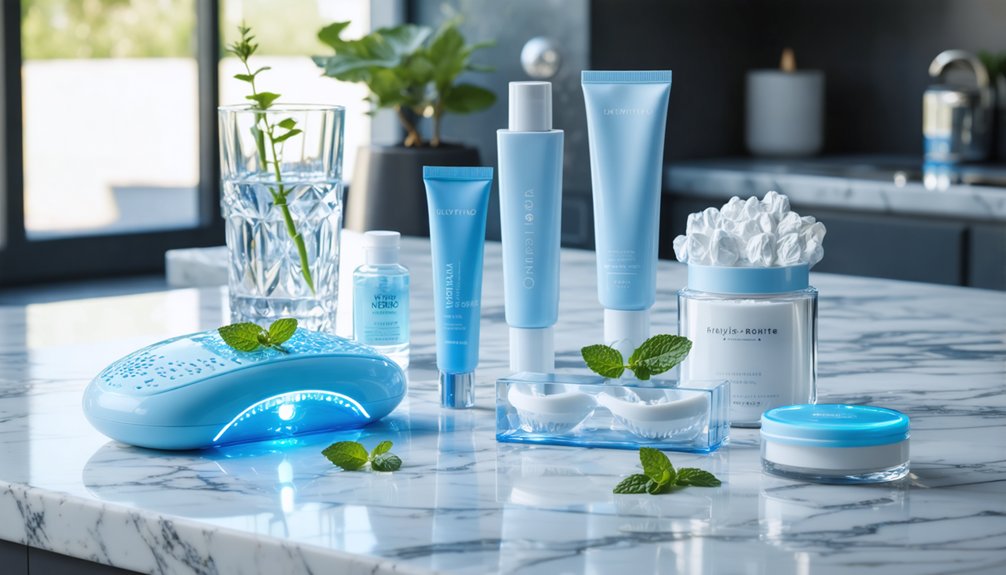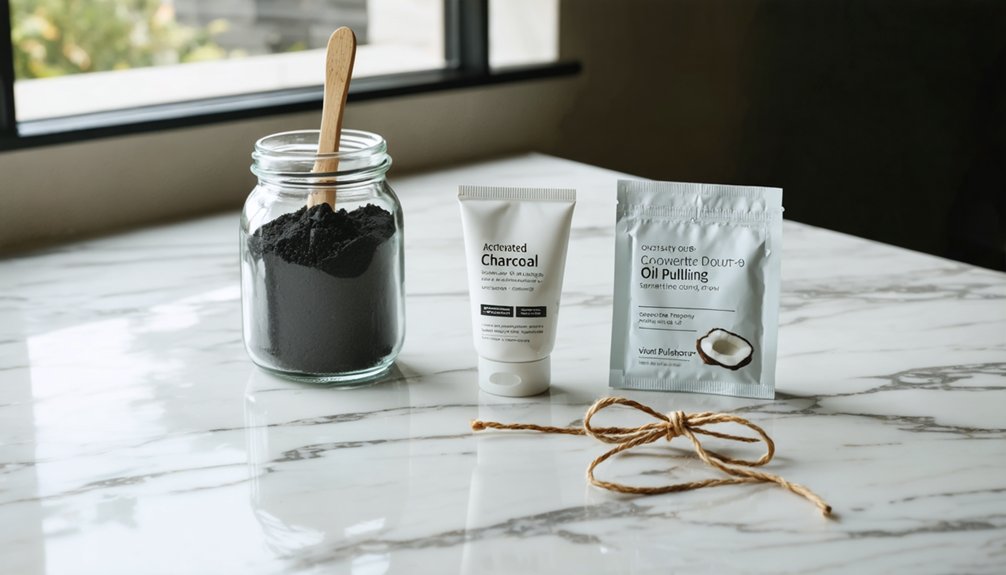If you have sensitive teeth, start whitening treatment by using desensitizing toothpaste with potassium nitrate 1-3 weeks before beginning. Choose low-concentration whitening products (10% carbamide peroxide or less) and get a professional cleaning first to remove surface stains. Use fluoride treatments to strengthen enamel, and consider custom-fitted trays to prevent gel contact with sensitive areas. For ideal results and minimal discomfort, you’ll want to understand the complete protocol for sensitive teeth whitening.
Key Takeaways
- Use desensitizing toothpaste containing potassium nitrate for 2-3 weeks before starting any whitening treatment to reduce sensitivity.
- Choose whitening products with lower peroxide concentrations (below 10%) and limit application times to 10-30 minutes.
- Schedule a professional cleaning before whitening to remove plaque and ensure even bleaching penetration.
- Apply fluoride treatments and desensitizing gels before and after whitening sessions to protect and strengthen enamel.
- Avoid hot, cold, and acidic foods for 48 hours after treatment while maintaining good oral hygiene with soft-bristled brushes.
Understanding Teeth Sensitivity and Whitening Options
When considering teeth whitening treatments, it’s crucial to understand how sensitivity develops and what options are available to minimize discomfort.
Unlike common whitening myths suggest, sensitivity occurs when bleaching agents like hydrogen peroxide and carbamide peroxide penetrate your enamel and dentin, reaching nerve endings. These agents temporarily open enamel pores, making your teeth more reactive to sensitivity triggers such as hot, cold, sweet, or acidic substances. Hard-bristled toothbrushes can increase sensitivity during whitening by further wearing down enamel.
You’ll find that at-home treatments using lower concentrations of carbamide peroxide (10-16%) typically cause less discomfort than professional treatments with higher hydrogen peroxide levels (up to 40%). Research shows that while both concentrations are safe, patients typically experience mild dental sensitivity that resolves within about one day.
The good news is that sensitivity is usually temporary, resolving as your enamel remineralizes through normal salivary processes after treatment completion.
Pre-Treatment Steps to Minimize Discomfort
To mitigate sensitivity during teeth whitening, you’ll need to prioritize enamel strengthening through desensitizing toothpaste and professional fluoride treatments at least 1-3 weeks before your procedure.
You should schedule a professional cleaning to remove surface stains and guarantee ideal whitening results by eliminating plaque and debris that could interfere with uniform bleaching. Your dentist may recommend taking over-the-counter pain medication before treatment to help reduce discomfort.
If you’re prone to sensitivity, you’ll benefit from selecting gentler treatment options with lower peroxide concentrations or customized trays for gradual whitening under professional supervision. Your dentist will need to verify you have good oral health before proceeding with any whitening treatments.
Strengthen Enamel First
Before beginning any teeth whitening treatment, strengthening your enamel serves as a critical foundation for minimizing sensitivity and ensuring ideal results.
Focus on enamel remineralization techniques by implementing fluoride-rich oral care products and maintaining consistent use of desensitizing toothpaste containing potassium nitrate. Professional fluoride varnish application provides concentrated protection while blocking nerve pain transmission. Working with dental professionals helps ensure optimal safety and effectiveness compared to over-the-counter options.
You’ll need to modify your dietary habits by eliminating acidic foods and beverages that can compromise enamel integrity. Instead, maintain proper hydration with room temperature water and neutral pH foods. Consider using lower peroxide levels when selecting whitening products to reduce the risk of sensitivity.
Apply specialized desensitizing gels as directed, and adopt gentle brushing techniques using a soft-bristled toothbrush. For best results, continue these enamel-strengthening protocols for 7-10 days before your whitening procedure and throughout the post-treatment period.
Schedule Professional Cleaning
Professional teeth cleaning serves as a foundational step in preparing your teeth for safe, effective whitening treatment while minimizing sensitivity risks. Schedule your cleaning frequency at least 1-2 weeks before whitening to allow proper tissue healing and enamel stabilization. Active tooth decay should be treated before proceeding with any whitening procedures.
During your cleaning appointment, your dentist will perform a thorough enamel evaluation to identify potential sensitivity triggers like erosion, recession, or exposed dentin. This evaluation helps determine if you need desensitizing toothpaste as part of your pre-treatment routine.
They’ll remove plaque and tartar that could interfere with even bleaching penetration, while applying protective fluoride treatments to strengthen your enamel. If needed, they’ll incorporate desensitizing agents containing potassium nitrate or strontium chloride to reduce nerve excitation.
Based on your sensitivity assessment, your dentist will customize your whitening protocol, adjusting concentrations and treatment duration to guarantee ideal results with minimal discomfort.
Choose Gentler Treatment Options
When managing teeth sensitivity during whitening treatments, selecting gentler options becomes essential for ideal comfort and results.
Start by using desensitizing toothpaste containing potassium nitrate at least two weeks before treatment to block nerve signals. Incorporate fluoride treatments to strengthen your enamel and reduce permeability through dentin tubule sealing. Professional dentists can provide personalized guidance to develop the most effective pre-treatment plan. Custom-fitted trays help prevent gel contact with sensitive gum tissue.
Choose whitening products with lower peroxide concentrations, ideally below 10% carbamide peroxide or 6.5% hydrogen peroxide. Apply professional desensitizing gels before treatment for immediate nerve pathway blocking.
Consider natural remedies like coconut oil pulling or gentle formulations with baking soda for gradual whitening effects. These alternatives typically cause less enamel erosion while supporting overall oral health.
Remember to avoid overfilling trays and maintain consistent use of desensitizing agents throughout your whitening process.
Safe Whitening Methods for Sensitive Teeth
If you’re dealing with tooth sensitivity, you’ll find both professional and at-home options for safe teeth whitening.
Your dentist can provide in-office treatments using controlled bleaching agents while monitoring your comfort levels and sensitivity responses throughout the procedure.
For at-home care, you can opt for specially formulated whitening toothpastes or custom-fitted trays with lower concentration gels that gradually brighten your teeth while minimizing discomfort.
Professional In-Office Options
Modern in-office teeth whitening procedures offer safe, effective solutions for patients with tooth sensitivity through precisely controlled applications and specialized formulations.
Professional treatments utilize custom trays and laser whitening technology with lower peroxide concentrations, buffering agents, and desensitizing ingredients like potassium nitrate and fluoride.
- Advanced LED and laser-assisted treatments activate gentle whitening gels while minimizing chemical exposure and pulp irritation
- Temperature-regulated procedures prevent enamel dehydration and protect sensitive nerve endings
- Real-time monitoring allows practitioners to adjust treatment intensity based on patient comfort
Your dentist will evaluate your sensitivity level to create a personalized protocol, often incorporating pre-treatment desensitizing regimens and multiple shorter sessions.
This staged approach, combined with precision-fitted trays and protective post-procedure care, guarantees ideal results while maintaining your comfort throughout the whitening process.
At-Home Gentle Treatments
People with sensitive teeth can safely achieve a brighter smile through gentler at-home whitening methods that minimize enamel irritation and nerve stimulation.
You’ll find success using specially formulated whitening toothpastes containing potassium nitrate or stannous fluoride, which protect nerve endings while lifting surface stains. For enhanced results, incorporate low-concentration whitening gels or strips designed specifically for sensitivity, limiting application times to 10-30 minutes.
Begin your whitening regimen with desensitizing toothpaste to strengthen enamel, and continue using it throughout treatment.
Consider natural whitening alternatives like gentle abrasives in sensitivity-formulated products, but avoid harsh, abrasive substances that could damage enamel.
Strategic timing of treatments and consistent monitoring will help prevent sensitivity flare-ups while gradually achieving your desired level of whiteness.
Managing Sensitivity During the Whitening Process

While teeth whitening remains a popular cosmetic procedure, managing sensitivity effectively during treatment requires a thorough approach that combines preventive measures, proper technique selection, and post-treatment care.
To minimize sensitivity triggers, use professional-grade custom-fitted trays and lower concentration peroxide formulations. Implement extensive pain management through pre-treatment desensitizing agents and post-whitening fluoride applications.
Professional-grade trays and lower peroxide concentrations, combined with targeted desensitizing treatments, create a more comfortable teeth whitening experience.
- Control thermal sensitivity by avoiding hot/cold foods and beverages for 48 hours post-treatment
- Apply desensitizing gels containing potassium nitrate before and after whitening sessions
- Use a soft-bristled toothbrush with lukewarm water to prevent mechanical irritation
For ideal results, space out your whitening treatments to allow proper enamel recovery, and maintain consistent use of sensitivity-targeted oral care products throughout the process.
Post-Treatment Care and Maintenance
Successful teeth whitening outcomes depend heavily on proper post-treatment care and maintenance protocols. After your whitening procedure, you’ll need to follow specific post treatment recommendations to protect your teeth’s enamel and minimize sensitivity.
Wait several hours before brushing, and when you do, use a soft-bristled brush with desensitizing toothpaste. Rinse with a pH-balancing mouthwash to restore ideal oral conditions.
For enamel protection, avoid hot, cold, and acidic foods for 48 hours post-treatment. Use a straw when consuming beverages, and maintain adequate hydration to support natural remineralization.
If you’re experiencing persistent sensitivity, consult your dentist about professional desensitizing treatments or modified whitening protocols. Regular dental check-ups will help monitor your enamel integrity and guarantee long-term whitening success while managing sensitivity concerns.
Key Ingredients for Sensitive Teeth Whitening

The selection of appropriate whitening ingredients plays an essential role in minimizing tooth sensitivity while achieving desired bleaching results.
When choosing whitening products for sensitive teeth, focus on formulations containing proven desensitizing agents like potassium nitrate and fluoride compounds that support enamel remineralization. Opt for lower concentration peroxide formulas (1.5-3%) combined with gentle abrasives like baking soda or nanohydroxyapatite.
- Look for products containing strontium chloride or calcium phosphate derivatives that effectively block exposed dentin tubules.
- Choose whitening agents with built-in fluoride compounds to strengthen enamel during treatment.
- Avoid harsh ingredients like sodium chlorite, high-concentration carbamide peroxide, or aggressive abrasives that can damage enamel.
Clinical studies confirm these ingredient combinations provide effective whitening while considerably reducing treatment-associated sensitivity.
Frequently Asked Questions
Can I Whiten My Teeth While Wearing Braces or Dental Crowns?
You shouldn’t attempt braces whitening, as it causes uneven results. Crown whitening won’t work since crowns don’t respond to bleaching agents. Wait until your braces are removed for best results.
How Long Should I Wait Between Professional Whitening Treatments?
Time is your teeth’s best friend! You’ll need to wait at least six months between professional whitening treatments. This ideal treatment interval protects your enamel and prevents prolonged sensitivity from frequent exposure.
Will Teeth Whitening Affect Existing Dental Fillings or Veneers?
Your teeth whitening treatment won’t change the color of existing fillings or veneers since they’re made from non-bleachable materials. For ideal fillings safety and veneer compatibility, consider whitening before getting new restorations.
Does Teeth Sensitivity From Whitening Treatments Indicate Permanent Damage?
You won’t experience permanent damage from whitening sensitivity – it’s typically reversible. Common sensitivity causes include temporary pulp inflammation and surface changes, while treatment options include desensitizing agents and reduced bleaching frequency.
Can Certain Medications Interfere With Teeth Whitening Effectiveness?
Yes, certain medications can reduce whitening effectiveness through intrinsic staining, dry mouth, and direct medication interactions. You’ll need professional guidance to explore suitable whitening alternatives that accommodate your medication regimen.
References
- https://www.stadiumfamilydentistryannarbor.com/teeth-whitening-tips-and-tricks-for-sensitive-teeth/
- https://www.encinitascosmeticdentistry.com/practice-news/how-to-prepare-sensitive-teeth-for-whitening/
- https://www.redrocksfamilydentistry.com/teeth-whitening-options-for-sensitive-teeth/
- https://www.scottgreenhalghdds.com/blog/10-tips-for-dealing-with-sensitivity-after-teeth-whitening
- https://www.goodrx.com/conditions/dental-care/sensitive-teeth-after-whitening
- https://precisiondentalnyc.com/10-tips-for-dealing-with-sensitivity-after-teeth-whitening/
- https://pmc.ncbi.nlm.nih.gov/articles/PMC4058574/
- https://www.drbobsdentalcare.com/is-teeth-whitening-safe-for-sensitive-teeth/
- https://www.parkcreekdentalcare.com/blog/teeth-whitening-for-sensitive-teeth-safe-options-that-work/
- https://fomm.amegroups.org/article/view/66778/html



